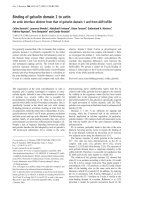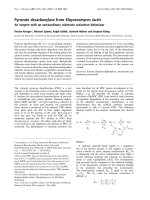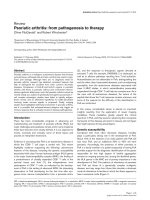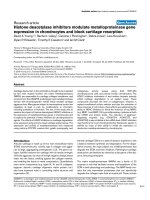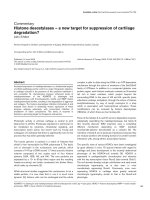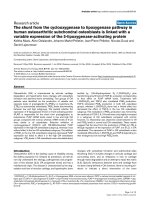Báo cáo y học: "Histone modifications: from genome-wide maps to functional insights" ppsx
Bạn đang xem bản rút gọn của tài liệu. Xem và tải ngay bản đầy đủ của tài liệu tại đây (97.86 KB, 6 trang )
Genome Biology 2005, 6:113
comment
reviews
reports
deposited research
interactions
information
refereed research
Opinion
Histone modifications: from genome-wide maps to
functional insights
Fred van Leeuwen and Bas van Steensel
Address: Netherlands Cancer Institute, Plesmanlaan 121, 1066 CX Amsterdam, The Netherlands.
Correspondence: Fred van Leeuwen. E-mail: Bas van Steensel. E-mail:
Published: 31 May 2005
Genome Biology 2005, 6:113 (doi:10.1186/gb-2005-6-6-113)
The electronic version of this article is the complete one and can be
found online at />© 2005 BioMed Central Ltd
The DNA in the nucleus of a eukaryotic cell is packed into
chromatin, the fundamental building block of which, the
nucleosome, consists of an octamer of the four histones
H2A, H2B, H3 and H4, around which the DNA is wrapped.
The histones within chromatin are subject to extensive post-
translational modification, including acetylation, methyla-
tion, phosphorylation, ubiquitination, and ribosylation.
Many enzymes have been identified that are responsible for
the addition or removal of modifications at one or a few spe-
cific histone amino-acid residues, and many histone modifi-
cations are believed to play important roles in the regulation
of transcription. Although some histone modifications may
cause alterations in the structure or overall charge of the
nucleosome [1,2], it is likely that most act by controlling the
docking of specific regulatory factors. For example, the chro-
modomain of heterochromatin protein 1 (HP1) binds to the
tail of histone H3 only when lysine 9 of H3 (H3K9) is methy-
lated, and this may contribute to repression of transcription
[3]. Similarly, the bromodomains of various transcriptional
activators and nucleosome-remodeling factors recognize
specific acetylated lysine residues within histone H3 or H4
[4]. While some modifications attract specific regulatory
factors, others appear to block protein binding. This is illus-
trated by the inhibitory effect of acetylation on the binding of
the silencing protein Sir3 to histone H4 [5]. Undoubtedly,
many more factors will be discovered that recognize particu-
lar modification states of histones.
Given the large number of histone modifications that appear
to be involved in the control of gene expression, the integra-
tion of their regulatory roles is an important issue. How do
these modifications work together? For example, H3K4
methylation and H3K9 acetylation have both been impli-
cated in gene activation; do these two modifications typically
act together on a common set of genes, or are they part of
separate signaling pathways each of which controls different
sets of genes? Can repressive signals (such as H3K9 methy-
lation) and activating signals (such as H3K4 methylation)
occur on the same nucleosome and, if so, how are their
effects integrated? Do the different modifications control
transcription mostly by simple additive or redundant mech-
anisms that are the same for different genes, or do they con-
stitute a complex combinatorial code, whereby the effect of
one modification differs between genes and depends on the
local context of other modifications (Figure 1)? Because of
the myriad combinations that may exist, these questions
cannot be solved by single-gene studies. Rather, it is neces-
sary to compare a large number of genes to identify the
global patterns, interrelationships, and functional roles of
histone modifications.
In the past few years, chromatin immunoprecipitation (ChIP)
combined with microarray detection (ChIP-on-chip) has
become the principal technique for mapping genome-wide
patterns of histone modifications [6,7]. Most laboratories use
Abstract
A large number of histone modifications has been implicated in the regulation of gene expression.
Together, these modifications have the potential to form a complex combinatorial regulatory code.
Genome-wide mapping approaches provide new opportunities to decipher this code, but they may
suffer from systematic biases. Integration of datasets and improved technologies will provide the
way forward.
a similar ChIP protocol, which involves cross-linking of
protein-DNA complexes in vivo by addition of formalde-
hyde to living cells, followed by lysis of the cells and
mechanical shearing of the chromatin to yield fragments of
about 0.5-2 kilobases in size. This is followed by immuno-
precipitation of cross-linked protein-DNA complexes using
antibodies against a specific epitope, such as a certain
histone modification. DNA is then recovered from the
immunoprecipitated complexes and labeled and hybridized
to DNA microarrays that bear thousands of sequences repre-
senting a large fraction of the genome. The presence or
absence of the histone modification at each genomic location
can then be inferred from the microarray signals, assuming
that the cross-linking efficiency and the epitope recognition
by the antibody are uniform across the entire genome.
Several laboratories have begun a systematic genome-wide
dissection of the relationships between histone modifica-
tions and transcriptional regulation, using combinations of
ChIP-on-chip, mRNA expression profiling, and other
methods. Here, we review the recent progress made (and
some problems encountered) in this new and exciting field.
Genome-wide distribution of nucleosomes
Before discussing whole-genome maps of histone modifica-
tions, it is useful to consider the genomic distribution of
nucleosomes (that is, the histone octamers) themselves. The
positioning of nucleosomes is believed to be crucial for gene
regulation. Two recent papers [8,9] describe the whole-
genome mapping of histone-genome interactions in the
budding yeast Saccharomyces cerevisiae. ChIP-on-chip
experiments were performed with epitope-tagged histone
H2B or H4, and endogenous H3 (using an antibody that is
presumably insensitive to the H3 modification state). The
results indicate that there are locus-specific differences in
nucleosome density. Most notably, the upstream regions of
highly active genes display a reduced nucleosome density
compared to the upstream regions of inactive genes. Deple-
tion of histone H2B in promoter regions was also detected by
a genome-wide mapping technique that combines ChIP with
mass sequencing of short sequence tags [10]. A similar deple-
tion of nucleosomes, although of lower magnitude, was
observed in coding regions of highly active genes, when com-
pared to inactive genes [8,9]. Although it cannot be com-
pletely ruled out that local differences in cross-linking
efficiency or epitope accessibility account for the observed
differences, the results are in agreement with detailed studies
of selected regions, such as the Pho5 promoter [11,12]. Thus,
these data suggest that, as a general rule, gene activation in
yeast is accompanied by reduced nucleosome density.
Histone modification maps: dealing with
possible biases
In order to understand the interplay between different
histone modifications during transcriptional regulation, it is
necessary to construct systematic genome-wide location
maps of all histone modifications and the proteins that
control and interact with them. Two laboratories have taken
important steps towards this goal by global mapping of a
large number of histone modifications. Kurdistani et al. [13]
performed ChIP-on-chip in S. cerevisiae using 11 antibodies,
each of which specifically recognizes a different acetylated
histone lysine residue. They used whole-genome arrays of
coding regions (ORFs) and intergenic regions (IGRs), thereby
creating complete genomic maps of these histone acetyla-
tions. Schübeler et al. [14] performed similar ChIP-on-chip
experiments in a cultured cell line from Drosophila
melanogaster, using antibodies against six distinct histone
modifications. But because the complete Drosophila genome
is not yet available on microarrays, these mapping experi-
ments were done with cDNA arrays, thus providing a view of
transcribed regions only. One modification (H3K4 dimethy-
lation) was also mapped using a genomic tiling array covering
the left arm of chromosome 2. Strikingly, both papers report
that the genomic distributions of virtually all tested histone
modifications are highly similar to one another. Schübeler et
al. [14] found that H3 and H4 acetylation, H3K4 di- and tri-
methylation, and H3K79 di-methylation, are all strongly cor-
related with each other, having pairwise Pearson correlation
coefficients of at least +0.7. Along the same lines, Kurdistani
et al. [13] report that all pairs of 11 tested acetylation sites
show significant positive correlations, with the majority of
113.2 Genome Biology 2005, Volume 6, Issue 6, Article 113 van Leeuwen and van Steensel />Genome Biology 2005, 6:113
Figure 1
Two models for the role of the different histone modifications. (a) Histone
modifications are linked, such that all active genes are marked by an
identical combination of ‘active’ histone modifications, and all inactive
genes by another common set of ‘repressive’ histone modifications.
(b) Histone modifications are not linked but form a complex combinatorial
code, such that various combinations of modifications mark (groups of)
active genes, and various other combinations mark inactive genes. Note
that some organisms (such as budding yeast) may lack ‘repressive’ histone
modifications.
Transcribed
Repressed
Gene X Gene Y
(a) Linked histone
modifications
(b) Gene-specific
combinations
of histone
modifications
Gene X Gene Y
correlation values (both in ORFs and in IGRs) being well
above +0.5.
Before we reflect on the potential biological implications, the
possibility should be considered that some kind of biological
or experimental bias is responsible for the strong correla-
tions. One possible source of bias could be local differences
in nucleosome density. It is conceivable that in genomic
regions with high nucleosome densities ChIP analysis of any
histone modification might yield stronger signals than in
regions with low nucleosome density [15] (Figure 2). Unfor-
tunately, the papers by Schübeler et al. [14] and Kurdistani
et al. [13] did not address this putative bias by including
control experiments with antibodies against histone epitopes
that lack potential modification sites. To illustrate the puta-
tive consequences of this bias, we compared the yeast histone
acetylation data from Kurdistani et al. [13] with yeast nucleo-
some-density maps [8,9] (Table 1). Strikingly, this analysis
reveals that especially within IGRs there is a considerable
correlation between H2B, H3 or H4 density and ChIP of
several of the lysine acetylation variants. These results argue
that ChIP of histone modifications may be biased by local
differences in nucleosome density. Given the strict 2:2:2:2
stochiometry of histones in the nucleosome, it is likely that
the bias is similar for modifications of all four histones.
Kurdistani et al. [13] reported that the acetylation levels in
IGRs of all tested lysines in histones H2A, H2B and H4 are
negatively (although weakly) correlated with expression
levels of the corresponding genes (Table 1). But when the
results are corrected for the nucleosome-density bias, it may
well be that these modifications are positively correlated
with gene expression. Likewise, the reported weakly positive
correlations between gene expression and acetylation of
H3K9, H3K18 and H3K27 in IGRs may in fact be more posi-
tive when corrected for nucleosome density. To further
investigate this bias, we compared the correlations of each
lysine acetylation with nucleosome density and with gene
expression levels (Figure 3). The striking linear relationship
between points on the plot shown in Figure 3 indicates that
these correlations are not independent, underscoring the
notion that the links between histone modification and gene
expression cannot be interpreted safely without a correction
for nucleosome density. Obviously, the bias caused by nucle-
osome-density differences may have implications for further
analyses and interpretations of all (previously published)
histone-modification maps.
comment
reviews
reports
deposited research
interactions
information
refereed research
Genome Biology 2005, Volume 6, Issue 6, Article 113 van Leeuwen and van Steensel 113.3
Genome Biology 2005, 6:113
Figure 2
Effect of nucleosome distribution on chromatin immunoprecipitation.
Uneven genomic distribution of nucleosomes (a) may cause a bias in the
results of chromatin immunoprecipitation experiments (b). The bias may
be solved by including ChIP controls for nucleosome density (see text)
and subsequent normalization of the histone-modification ChIP data.
2.5
Transcribed
Transcribed gene
Histone
modification
Nucleosome
density
Normalized
histone
modification
Repressed gene
Repressed
2
1.5
1
0.5
0
(a)
(b)
Table 1
Correlations between intergenic histone acetylation patterns,
levels of gene expression and histone density
ChIP Gene
epitope expression H4 density H3 density H2B density
H4K16 -0.18** +0.42** +0.43** +0.35**
H4K8 -0.15** +0.35** +0.41** +0.35**
H4K12 -0.08* +0.30** +0.38** +0.30**
H2AK7 -0.10* +0.29** +0.30** +0.27**
H2BK11 -0.13** +0.29** +0.32** +0.26**
H2BK16 -0.13** +0.28** +0.32** +0.26**
H3K14 -0.10* +0.26** +0.34** +0.27**
H3K23 -0.04 +0.15** +0.22** +0.16*
H3K9 +0.07 +0.06 +0.08* +0.07
H3K27 +0.08* -0.03 +0.00 +0.02
H3K18 +0.21** -0.08* -0.10* -0.05
The correlations shown are between intergenic histone acetylation
patterns [13] and levels of gene expression (data taken from [13]), and
the experimentally mapped densities of tagged histone H4 [8], and
untagged H3 and tagged H2B [9]. Pearson correlation coefficients are
shown, which can range from -1 (perfect inverse correlation) through 0
(no correlation) to +1 (perfect positive correlation). Correlations were
calculated for 1,580 intergenic regions that were represented in all three
datasets; significance, *p < 10
-3
, **p < 10
-8
.
It is not known whether depletion of nucleosomes in tran-
scriptionally active regions is a general phenomenon in
Drosophila. Schübeler et al. [14] performed ChIP-on-chip
with an antibody against phosphorylated H3S10 as a control,
and reassuringly found that this epitope does not correlate
with any of the other modifications, although one might
argue that this is not an entirely satisfying control because
H3S10 phosphorylation is primarily a mitosis-specific mark
[16]. Importantly, Schübeler et al. [14] report strong positive
correlations between all mapped acetylation and methyla-
tion patterns and gene expression levels. Correction for
nucleosome depletion in active regions would further
increase these correlations, and therefore would only
strengthen the conclusion that H3 and H4 acetylation, H3K4
di- and tri-methylation, and H3K79 di-methylation are all
enriched in regions of high transcriptional activity. Although
other experimental biases cannot be ruled out, these results
argue that, at least in coding regions of the fly genome, these
histone modifications are closely linked.
Interestingly, a recent mapping study of histone modifica-
tions in human cells suggests that linkage between active
histone modifications might be a common theme in eukary-
otic genomes. By combining ChIP with hybridization on
tiling oligonucleotide arrays, Bernstein et al. [17] showed
that more than 90% of H3K4 methylated sites on human
chromosomes 21 and 22 are also H3K9K14-acetylated.
Virtually no variation was found in H3 density, suggesting
that in human cells differences in nucleosome occupancy are
minor, and thus are unlikely to cause severe biases in the
mapping of histone modifications.
Genome-wide functional analysis of histone
modifications
Unraveling the role of histone modifications can be greatly
facilitated by genome-wide analysis of histone-modifying
enzymes. Such studies of histone deacetylases (HDACs) and
histone acetyltransferases (HATs) in yeast argue that acety-
lation of most histone lysine residues is in general positively,
not negatively, associated with gene expression. ChIP-on-
chip mapping of histone acetylation patterns after deletion
of either Rpd3 or Hda1 (both are HDACs) revealed increased
acetylation of several histone lysine residues [18]. Compari-
son of these ‘deacetylation maps’ with expression profiles
obtained after deletion of either HDAC revealed that
increased acetylation is generally accompanied by increased
transcription [18]. This was found for six different acetyla-
tion positions, including H4K12, H4K16, and H2BK16. Fur-
thermore, genome-wide mapping of the binding sites of the
HATs Gcn5 and Esa1 in yeast show that these enzymes are
primarily recruited to active genes [19]. These data further
support the view that for many lysines on the nucleosome
acetylation is generally positively linked to transcription.
While there seems to be a general correlation between
histone acetylation and gene expression, some histone
deacetylases seem to positively regulate gene expression,
possibly by maintaining the amount of histone acetylation
that is optimal for efficient transcription [20].
Another study employed expression profiling of yeast strains
in which lysines on histone H4 were systematically mutated
to arginine (which mimics unacetylated lysine) [21]. Muta-
tions of lysines 5, 8, and 12 had identical effects on the
expression of a broad set of genes. These effects were cumu-
lative: changes in expression were proportional to the
number of mutations. In contrast, mutation of H4K16
affected a distinct small group of genes. These results point
to a nonspecific, cumulative regulatory role for H4K5, H4K8,
and H4K12 acetylation.
Linked histone modifications?
Theoretically, the large number of possible histone modifica-
tions creates the potential for an extremely complex regula-
tory code. Nevertheless, careful comparison of the recent
whole-genome studies of histone modifications, as discussed
above, suggests a rather simple picture: most of the mapped
modifications, including acetylation of all tested nucleosomal
lysines and methylation of H3K4 and H3K79, are positively
correlated with levels of gene expression. This raises the
possibility that the different ‘active’ histone marks are
linked. So far, no histone modifications have been identified
113.4 Genome Biology 2005, Volume 6, Issue 6, Article 113 van Leeuwen and van Steensel />Genome Biology 2005, 6:113
Figure 3
Comparison of the correlations of ChIP of each lysine acetylation with
nucleosome density and with gene expression levels. Data are from Table 1.
Correlation of lysine acetylation ChIP
with gene expression
Correlation of lysine acetylation ChIP
with nucleosome density
H2AK7
H2BK11
H2BK16
H3K14
H3K18
H3K23
H3K27
H3K9
H4K12
H4K16
H4K8
−0.1
0.0
0.1
0.2
0.3
0.4
0.5
−0.2 −0.1 0.0 0.1 0.2
that mark transcriptionally inactive regions in budding
yeast. In other eukaryotes, however, a number of such
repressive marks have been reported, such as methylation of
H3K9, H3K27, and H4K20. The degree of global linkage of
these repressive histone marks remains to be established.
How may the linkage of various active histone modifications
be established? In part, it may be a consequence of the broad
substrate-specificity of some histone-modifying enzymes.
For example, the HDAC Rpd3 and the HAT Gcn5 both
control the acetylation state of several lysines on H3 and H4
[18,22]. Furthermore, several histone-modifying enzymes
might act at the same nucleosome because they interact with
each other (for example, the TAC1 chromatin-remodeling
complex has both H3K4 methyltransferase activity and HAT
activity [23]), or because they are recruited by the same
signal (for example, the H3K4, H3K36, and H3K79 methyl-
transferases in yeast all require components of the Paf1
complex for their activity [24]). In addition, certain histone
modifications may recruit complexes containing other modi-
fying enzymes and thus trigger cascades of histone modifica-
tions (for example, methylation on H4R3 by PRMT1
facilitates acetylation by p300 on H4K8 and H4K12 [25]) It
is conceivable that such cascades could be initiated by differ-
ent initial modifications, yet ultimately result into the same
set of modifications.
Why would multiple histone modifications be employed in
parallel to control transcription? Partially redundant func-
tions of histone marks in chromatin might confer robustness
on epigenetic regulation. Thus, transcriptional responses
might be largely independent of small changes in any single
modification and the cell might have several options to
induce transcriptional changes (changes in transcription can
be elicited by inhibition or activation of one of several differ-
ent histone-modification pathways) [26]. Despite the evi-
dence that many active histone modifications are globally
linked, it is likely that there are also differences between
combinations of histone modifications that mark specific
genes (Figure 1). It should be emphasized that the current
ChIP-on-chip maps do not contain information about the
timing of (sequential) events, as the maps were generally
obtained from asynchronous cell populations. Moreover,
ChIP-on-chip does not have single-nucleosome resolution,
which may complicate the interpretation: it is formally pos-
sible that certain nucleosomes in a particular IGR or coding
region carry functionally important modifications that differ
from those in the surrounding nucleosomes. Indeed,
detailed ChIP analysis of individual genes suggests that
trimethyl-H3K4 occurs predominantly in the 5Ј part of tran-
scribed regions whereas dimethyl-H3K4 has a much broader
distribution [17,27-29]. Furthermore, the different pheno-
types and expression profiles that result from inactivation of
the enzymes that control the active marks argue that the
respective histone modifications can have distinct effects on
gene expression.
The high correlations between histone modifications as
reported by Schübeler et al. [14] and Kurdistani et al. [13]
may have been overestimated as a result of differences in
nucleosome densities or other unknown biases. Interest-
ingly, for a series of additional analyses of the yeast histone
acetylation maps, Kurdistani et al. [13] employed a data-
normalization procedure called variance normalization. The
first step of this normalization involves the subtraction (for
each probed locus) of the average of all 11 measured acetyla-
tion levels from each individual acetylation level. If the pre-
sumed nucleosome-density bias is indeed similar for all
histone epitopes, then this normalization procedure would
at least partially correct for the bias, although the residual
values after such a subtraction may have a high noise
content. Intriguingly, after variance normalization and the
subsequent use of a clustering algorithm, Kurdistani et al.
[13] identified clusters of functionally related genes that
were enriched in certain histone-acetylation patterns.
Further experiments are needed to reveal the functional rel-
evance of the relationships between histone-modification
patterns and gene functions.
Histone-modification maps in the future
In addition to revealing interesting biological information,
recent whole-genome mapping studies have also revealed
some technical hurdles that still need to be overcome if we
are to construct highly reliable epigenetic maps. First,
improved experimental methods are required. Inclusion of
control ChIPs, of modification-free histone epitopes or
tagged histones, may help to solve the potential bias prob-
lems associated with ChIP-on-chip. It will also be crucial to
verify whole-genome ChIP results by an independent
method because the exact choice of procedures used for
ChIP (such as the type of cross-linker, the extent of cross-
linking, fractionation of chromatin, and experimental condi-
tions that may cause cellular stress responses) can affect the
outcome of a ChIP-on-chip experiment [19,30-32]. At
present, no alternative genome-wide method is available for
ChIP analysis of histone modifications. The DamID technol-
ogy, which employs tethered Dam methyltransferase [33],
provides an independent means for verifying the global
binding data of histone-modifying enzymes and other chro-
matin-associated proteins, but it is not suitable for mapping
histone modifications.
A second challenge lies in the integration of histone-modifi-
cation maps with other whole-genome chromatin datasets,
such as gene-expression profiles, global maps of DNA
methylation, DNase-hypersensitive sites, and the binding of
histone-modifying enzymes and other chromatin-interacting
proteins. For example, a recent mapping study in Arabidop-
sis revealed tight links between methylation of H3K9,
hypomethylation of H3K4, and methylation of DNA in a
heterochromatic region of the genome [34]. Whole-genome
datasets are extremely complex, however, and each mapping
comment
reviews
reports
deposited research
interactions
information
refereed research
Genome Biology 2005, Volume 6, Issue 6, Article 113 van Leeuwen and van Steensel 113.5
Genome Biology 2005, 6:113
approach yields different information. Moreover, most of the
current data should be regarded as probabilistic because of
the rather high noise levels. Advanced statistical techniques,
such as Bayesian network models [35], may be essential for
the successful integration of different types of data and the
eventual construction of useful biological models. Despite
these challenges, the genome-wide exploration of chromatin
structure and function is well on its way.
References
1. Peterson CL, Laniel MA: Histones and histone modifications.
Curr Biol 2004, 14:R546-R551.
2. Khorasanizadeh S: The nucleosome: from genomic organiza-
tion to genomic regulation. Cell 2004, 116:259-272.
3. Brehm A, Tufteland KR, Aasland R, Becker PB: The many colours
of chromodomains. BioEssays 2004, 26:133-140.
4. Zeng L, Zhou MM: Bromodomain: an acetyl-lysine binding
domain. FEBS Lett 2002, 513:124-128.
5. Carmen AA, Milne L, Grunstein M: Acetylation of the yeast
histone H4 N terminus regulates its binding to heterochro-
matin protein SIR3. J Biol Chem 2002, 277:4778-4781.
6. Bernstein BE, Humphrey EL, Liu CL, Schreiber SL: The use of chro-
matin immunoprecipitation assays in genome-wide analyses
of histone modifications. Methods Enzymol 2004, 376:349-360.
7. Robyr D, Kurdistani SK, Grunstein M: Analysis of genome-wide
histone acetylation state and enzyme binding using DNA
microarrays. Methods Enzymol 2004, 376:289-304.
8. Lee CK, Shibata Y, Rao B, Strahl BD, Lieb JD: Evidence for nucleo-
some depletion at active regulatory regions genome-wide.
Nat Genet 2004, 36:900-905.
9. Bernstein BE, Liu CL, Humphrey EL, Perlstein EO, Schreiber SL:
Global nucleosome occupancy in yeast. Genome Biol 2004, 5:R62.
10. Roh TY, Ngau WC, Cui K, Landsman D, Zhao K: High-resolution
genome-wide mapping of histone modifications. Nat Biotech-
nol 2004, 22:1013-1016.
11. Reinke H, Horz W: Histones are first hyperacetylated and
then lose contact with the activated PHO5 promoter. Mol
Cell 2003, 11:1599-1607.
12. Boeger H, Griesenbeck J, Strattan JS, Kornberg RD: Nucleosomes
unfold completely at a transcriptionally active promoter.
Mol Cell 2003, 11:1587-1598.
13. Kurdistani SK, Tavazoie S, Grunstein M: Mapping global histone
acetylation patterns to gene expression. Cell 2004, 117:721-733.
14. Schübeler D, MacAlpine DM, Scalzo D, Wirbelauer C, Kooperberg
C, van Leeuwen F, Gottschling DE, O’Neill LP, Turner BM, Delrow J,
et al.: The histone modification pattern of active genes
revealed through genome-wide chromatin analysis of a
higher eukaryote. Genes Dev 2004, 18:1263-1271.
15. Hanlon SE, Lieb JD: Progress and challenges in profiling the
dynamics of chromatin and transcription factor binding with
DNA microarrays. Curr Opin Genet Dev 2004, 14:697-705.
16. Wei Y, Yu L, Bowen J, Gorovsky MA, Allis CD: Phosphorylation
of histone H3 is required for proper chromosome condensa-
tion and segregation. Cell 1999, 97:99-109.
17. Bernstein BE, Kamal M, Lindblad-Toh K, Bekiranov S, Bailey DK,
Huebert DJ, McMahon S, Karlsson EK, Kulbokas EJ 3rd, Gingeras TR,
et al.: Genomic maps and comparative analysis of histone
modifications in human and mouse. Cell 2005, 120:169-181.
18. Robyr D, Suka Y, Xenarios I, Kurdistani SK, Wang A, Suka N, Grun-
stein M: Microarray deacetylation maps determine genome-
wide functions for yeast histone deacetylases. Cell 2002,
109:437-446.
19. Robert F, Pokholok DK, Hannett NM, Rinaldi NJ, Chandy M, Rolfe
A, Workman JL, Gifford DK, Young RA: Global position and
recruitment of HATs and HDACs in the yeast genome. Mol
Cell 2004, 16:199-209.
20. Wang A, Kurdistani SK, Grunstein M: Requirement of Hos2
histone deacetylase for gene activity in yeast. Science 2002,
298:1412-1414.
21. Dion MF, Altschuler SJ, Wu LF, Rando OJ: Genomic characteri-
zation reveals a simple histone H4 acetylation code. Proc Natl
Acad Sci USA 2005, 102:5501-5506.
22. Suka N, Suka Y, Carmen AA, Wu J, Grunstein M: Highly specific
antibodies determine histone acetylation site usage in yeast
heterochromatin and euchromatin. Mol Cell 2001, 8:473-479.
23. Smith ST, Petruk S, Sedkov Y, Cho E, Tillib S, Canaani E, Mazo A:
Modulation of heat shock gene expression by the TAC1
chromatin-modifying complex. Nat Cell Biol 2004, 6:162-167.
24. Gerber M, Shilatifard A: Transcriptional elongation by RNA
polymerase II and histone methylation. J Biol Chem 2003,
278:26303-26306.
25. Wang H, Huang ZQ, Xia L, Feng Q, Erdjument-Bromage H, Strahl
BD, Briggs SD, Allis CD, Wong J, Tempst P, et al.: Methylation of
histone H4 at arginine 3 facilitating transcriptional activa-
tion by nuclear hormone receptor. Science 2001, 293:853-857.
26. Schreiber SL, Bernstein BE: Signaling network model of chro-
matin. Cell 2002, 111:771-778.
27. Santos-Rosa H, Schneider R, Bernstein BE, Karabetsou N, Morillon
A, Weise C, Schreiber SL, Mellor J, Kouzarides T: Methylation of
histone H3 K4 mediates association of the Isw1p ATPase
with chromatin. Mol Cell 2003, 12:1325-1332.
28. Ng HH, Robert F, Young RA, Struhl K: Targeted recruitment of
Set1 histone methylase by elongating Pol II provides a local-
ized mark and memory of recent transcriptional activity.
Mol Cell 2003, 11:709-719.
29. Morillon A, Karabetsou N, O’Sullivan J, Kent N, Proudfoot N, Mellor
J: Isw1 chromatin remodeling ATPase coordinates tran-
scription elongation and termination by RNA polymerase II.
Cell 2003, 115:425-435.
30. Kurdistani SK, Robyr D, Tavazoie S, Grunstein M: Genome-wide
binding map of the histone deacetylase Rpd3 in yeast. Nat
Genet 2002, 31:248-254.
31. Humphrey EL, Shamji AF, Bernstein BE, Schreiber SL: Rpd3p relo-
cation mediates a transcriptional response to rapamycin in
yeast. Chem Biol 2004, 11:295-299.
32. Schwartz YB, Kahn TG, Pirrotta V: Characteristic low density
and shear sensitivity of cross-linked chromatin containing
polycomb complexes. Mol Cell Biol 2005, 25:432-439.
33. van Steensel B, Delrow J, Henikoff S: Chromatin profiling using
targeted DNA adenine methyltransferase. Nat Genet 2001,
27:304-308.
34. Lippman Z, Gendrel AV, Black M, Vaughn MW, Dedhia N, McCom-
bie WR, Lavine K, Mittal V, May B, Kasschau KD, et al.: Role of
transposable elements in heterochromatin and epigenetic
control. Nature 2004, 430:471-476.
35. Beer MA, Tavazoie S: Predicting gene expression from
sequence. Cell 2004, 117:185-198.
113.6 Genome Biology 2005, Volume 6, Issue 6, Article 113 van Leeuwen and van Steensel />Genome Biology 2005, 6:113
